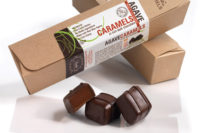Caramels
Creamy and delicious, this stalwart of the candy category is here to stay.
Traditional Caramels Estimated U.S. Retail Market Size
$72 million
$72 million
Source: Confectioner estimate based on input from
industry players
Overview
Caramels are a candy category basic. No candy set is
complete without them. And thanks to their calcium content and relatively
low-fat profile, caramels enjoy the benefit of a healthful product
positioning.
Also on the good news front, consumers have been
warming to the presence of caramel as an ingredient in everything from
limited edition candy bars to Ho Ho’s snack cakes and specialty
lattes. You can even buy prepared apple slices packed with caramel dips for
lunchbox treats. And Kraft’s Food & Family magazine named caramel
one of its top five flavors for 2006, touting its versatility and the fact
that it partners nicely with both sweet, creamy treats and salty snacks.
Caramel ingredient suppliers report double-digit sales growth.
Of course, caramel’s starring role as an
ingredient hasn’t translated all that well to the caramel candy
category. In fact, sales of caramel candy + taffy apples/kits/dips declined
5.8% in food/drug/mass excluding Wal-Mart for the 52 weeks ending Oct. 30,
2005. Clearly, even more product development and marketing creativity is
required to generate consumer enthusiasm.
Marketing/Merchandising
Caramel makers have done their bit to add excitement
to caramels — inside and out, i.e. via fillings and coatings.
Fillings are especially varied and have included guava, strawberry,
coconut, vanilla, chocolate and even peanut butter. Of course, caramels
themselves have been flavored and paired with creams to deliver new taste
and texture experiences to consumers. Caramels are considered by many candy
lovers as something of a comfort food with strong nostalgia appeal. While
that’s certainly a viable positioning, caramel makers also are doing
their best to introduce new forms and flavor combinations to keep the
category contemporary.
Adjacencies
Because caramels share the buttery flavor notes of
toffees, positioning these products side by side in the candy aisle makes
sense. Large laydown bags are the No. 1 seller in the packaged caramel
segment, although smaller peg bags and even theater boxes play a role.
Caramels should not be ignored within any bulk retail display; bulk candy
vendors report that they are strong performers.
Seasonal Opportunities
Almost 80 percent of caramel sales occur in the fall.
More and more, traditional caramels are competing with convenience products
like wraps and dips, so they need to be merchandised just as creatively in
the store with high-impact placement in the produce section near the
apples.
And how about extending the applications with creative
seasonal recipes presented at point-of-purchase and on packaging. Caramel
apple pie, anyone?
Outlook
Watch for more gourmet caramel offerings, as well as
some sugar-free versions targeted to the category’s aging core boomer
consumer.
Innovative packaging — say a squeezable tube
that allows the user to dribble caramel into an opened mouth or onto
another food or snack item — might also provide a boost to the
category.

